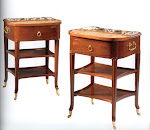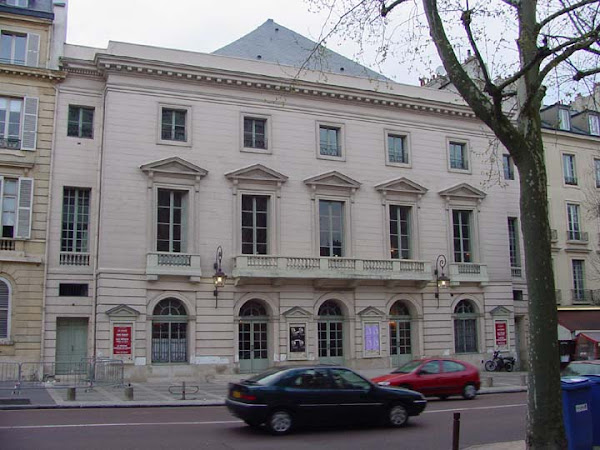Louise-Elizabeth, Enfant de France was the first daughter of Louis XV.
Her pet name was Babette. The gallant King of France never minced words with regard to Babette. She was his unquestioned
favourite!
This is Louise-Elizabeth as a young lady by the preferred court portraitist of the day at Versailles, Nattier.
Louis XV was an unrelenting lover of women, of hunting, of beauty and civilized living... The decorative arts in France and the Court of Versailles during his reign (1715-1774) reached an apogee that many decorative arts historians to this day believe have never been surpassed. This is a famous pastel portrait of the King of France by De La Tour.
Below is a portrait, also by Nattier, depicting a grown and married Louise-Elizabeth in hunting dress during one of three of her return visits to see her family at the French court at Versailles after her departure to marry abroad in 1739 at the age of 12. She revisited Versailles in 1748, again in 1752 after the death of her twin sister Madame Henriette and again in 1757 until 1759. Her father's love was emphatically reciprocated.
Louise-Elizabeth grew up seeing and obviously coming to appreciate the best furniture, tapestry, ormolu, porcelain and other related decorative arts that she clearly brought with her when obliged to relocate and leave Versailles to marry her cousin once removed, Don Felipe (Philip), a Spanish Prince who was destined to eventually become Duke of Parma. Philip became the reigning Duke of Parma which was handed to him thanks to the endless machinations of his tirelessly ambitious mother, Isabella Farnese (Queen Consort to the Spanish King Philip V to whom she was his second wife) whose family had once been reigning dukes of Parma. Her tireless efforts and intrigue paid off. She was able to regain the Duchy of Parma on his behalf as a result of the Treaty of Aix-la-Chapelle in 1748.
Below is Philip's portrait as Duke of Parma by an unknown court artist. As as ruler, Philip was notably competent and he seems to have been receptive to many of the exciting new ideas that characterized his century which were part of what is today known as The Age of Enlightenment. During his reign (1748-1765) Parma and the court welcomed numerous savants including accomplished personages from the ranks of the less widely known philosophes Such as Etienne Bonnot de Condillac. During his reign, education and philosophical discourse were nurtured widely and successfully.
Below is a state portrait of Louise Elizabeth by Charles Andre van Loo who has tactfully flattered her while not concealing her double chin. She was well known to be a chubby woman all her adult life. .
Below is a very revealing family portrait of the Duke and Duchess of Parma chez eux depicted rather informally in Louise-Elizabeth's private apartments in their preferred residence, the Palazzo Colorno. The court artist who painted this very welcoming image depicting royal coziness was Giuseppi Baldrighi. It was painted in 1757 on the eve of Louise Elizabeth's final return visit to Versailles and where she died of Smallpox in 1759. The Ducal couple did not have a happy marriage. But they managed to secure the succession for the throne of the Duchy of Parma. And as this portrait clearly depicts, they had a son (the future Ferdinand who succeeded his father Philip of as Duke of Parma in 1765), and two additional daughters. The smaller daughter on the left is the future Queen Maria Louisa of Spain.
Below is the Ducal Family's preferred official residence, the Palazzo Colorna. Today it houses one of the World's most admired culinary schools! During the reign of Philip and Louise-Elizabeth, it was where some of the finest examples of the art of Parisian ebenisterie and menuiserie and other glorious examples of sumptuous French court decorative art were assembled so that the Duchess of Parma could bring the decor of Versailles to which she was accustomed and which she clearly sought to recreate around her in her new home abroad.
Archival records enlighten decorative arts historians that the Ducal couple relied on an agent named Bonnet, working on their behalf with various artisans and marchands merciers to procure a staggering quantity of important and superior furniture, clocks, lighting, chenets for the fireplaces, tapestries, porcelain, and other related items to complete Louise-Elizabeth's objective of recreating the atmosphere of Versailles at the court of Parma. Below is an animated pair of ormolu chenets for the fireplace depicting courtly huntsmen which was procured for Louise-Elizabeth by Bonnet, in Paris in 1752, from the ciseleur doreur Le Lievre.
Below is another pair that was purchased from the marchand mercier Chez Boucher et Chez Jacquemin in 1754. These were actually in the Ducal Palace apartment of Monsieur de la Combe who was in charge of the Ducal Guarde-Robe. It is in the buoyant Chinoiserie style and after a model believed to be by Thomas Germain.
The Ducal Palace had a vast collection of clocks by the best clock makers of the day such as Lepautre and Julien Le Roy. The current whereabouts of some of these clocks is unknown. But some do exist today. Among the more notable clocks remaining is this one seen below. It is by Dennis Masson and was acquired by the Duke of Parma in 1759.
The more extravagant clock below is of tortoiseshell with ormolu with an allegorical decorative scheme and is signed by Jacques Panier who was known for making clocks with fine repeater movements. It was probably acquired from the marchand mercier Testard in Paris in 1754 and matches a description in an archived invoice that states it was sold for 260 livres.
The Duke and Duchess of Parma seem to have relied a great deal on Bonnet, He was probably involved in the negotiations that led to the acquisition of considerable quantities of exceptionally fine tapestries from the Royal Manufacture of Tapestries founded by Louis XIV at Gobelins.
Below is a Gobelins tapestry depicting a very romanticized and luscious depiction of the New World after the artist Desportes from a series entitled Nouvelles Indes.
Below is another Gobelins tapestry depicting the adventures of the Spanish character immortalized by Miguel de Cervantes, Don Quixote. The series acquired by the Duke and Duchess of Parma, of which we see one example, was after cartoons by Antoine Coypel.
Note the ravishingly carved and gilded suites of seating furniture seen above and below which give an idea of the sumptuous triumphs of the art of the menuiseur in the Ducal collection... Records indicate that the carved and gilded menuiserie that mostly included seating furniture were by the very best artisans of the period such as Avisse, Tilliard (who was a great favourite of Madame de Pompadour with whom Louise-Elizabeth became acquainted in 1748), Foliot and Cresson!
Below are more examples. Do note how the seating furniture was created en chassis. The upholstery could be consequently changed to suit furnishing needs in winter and summer with alternating covering. Winter seating seems to have been mostly with Gobelins tapestry.
In this portrait seen below of Louise-Elizabeth and Philip's son and successor Ferdinand by Johann Zoffany, note the tapestry upholstery has been changed for summer with green silk damask.
The acquisitions also included this cartonnier seen below with five gilded leather fronted compartments surmounting a frieze of three veneered drawers over a front case with a diamond trellis design. It is missing the ormolu clock that would have certainly been placed atop.
Below, another portrait of Ferdinand as a youth depicts a bureau plat and cartonnier from the ducal collections acquired in France by his parents. But you'll note how the cartonnier seen in this portrait does have the clock intended for it.
The two encoigneurs below are also part of the cartloads of exceptional Parisian ebenisterie to make their way to the court of Parma. On the left, by an unknown ebeniste, the encoigneur was ordered for the private apartments of Louise-Elizabeth at the Palazzo Colorno. On the right, the encoigneur is attributed to Jacques Dubois. It is noted by its fine floral marquetry and no less finely defined ormolu that is strikingly similar to a desk by Dubois ordered by the Duc de Choiseuil that is now in the collection of the Louvre Museum.
However, among the most superb examples of ebenisterie in the Ducal collection was this commode ordered from Bernard Van Riesen Burgh that has a veneer of consummately executed Vernis Martin imitating Asian lacquer embellished by gleaming ormolu mounts. This commode was acquired and placed in the apartments of La Marquise de Leyde who enjoyed a very important position in the household of the Duchess of Parma. Though, after the return of the marquise to Versailles in 1754 it was retained in the Ducal collection.
Other commodes with veneers of fine and rare wood included these two below... The one directly below is by Jacques Dubois.
The commode seen below is by Jean Pierre Latz. But note how both
commodes are embellished by identical ormolu mounts. This is not unusual
as the guild system that ensured this Olympian quality in the art of
Parisian ebenisterie before the French Revolution forbade an ebeniste to apply mounts made by his studio. The ormolu had to be supplied by a ciseleur doreur and it was not surprising that two ebenistes would work with the same ciseleur doreur. If not the ebeniste, the marchand mercier
might understandably be responsible for the choice of ormolu if he was
directing the production of the artisans, as was often the case.

Another important example of the Duchess' acquisition of Parisian furniture was this exuberantly designed bureau plat that once occupied pride of place in the grands apartments of Louise-Elizabeth in the Palazzo Colorna. It is attributed to Charles Cressent. The ormolu mounts are especially important and have the "C" couronné stamps that were done only during the period of 1745-1749. The quality of the ormolu in this bureau plat is outstanding in its execution with dazzling surfaces and extavagantly assertive female busts on the cariatid mounts seen on the four legs. It is seen below.
The eventual dispersal of the Ducal collections in the 19th Century and the Unification of Italy destined such furniture of regal quality to eventually end up at the Palazzo Quirinal in Rome. Formerly the residence of the Pope, after Italian Unification, it became the official residence of the Kings of Italy and later became the official residence of the President of Italy after the loss of the Italian Monarchy in the wake of WWII.
However, not all of the exceptionally fine furniture ordered from Paris by the Duke and Duchess of Parma ended up at the Palazzo Quirinal. This portrait at the Metropolitan Museum in New York seen below depicts the youngest daughter of Philip and Louise-Elizabeth of Parma named Marie-Louisa. She was married to her cousin the Spanish Prince of Austurias who later became Carlos IV. As his consort Maria-Louisa became one of Spain's most controversial queens, patron of Goya and mistress of Manuel Godoy, her husband's no less controversial minister. In the portrait below, the young Maria Louisa is seen with another fauteuil `a la reine by Nicholas-Quinibert Foliot that is believed to be after a design by Contant d'Ivry...
... And the same museum is fortunate enough to also have the same fauteuil in the Wrightsman Galleries which is seen below in the salon the Metropolitan Museum has from the Palais Paar in Vienna. As you can note, this fauteuil enviably retains its original upholstery. Having grown up surrounded by furniture, tapestry, and other objects of such outstanding beauty and quality, Maria Louisa would also go on to become one of the most discerning patrons of decorative arts as Queen of Spain as can be seen by all the interiors she occupied and had decorated for her at the Palacio Real in Madrid as well as other Spanish Royal residences.
We are indeed fortunate that Louis XV's eldest daughter was such a discerning woman of enlightened taste in the best of the decorative arts of a time that the art of the cabinet maker, the bronze smith, and the tapestry weaver reached unparalleled heights of unapologetic perfection! Without her prodigious Royal orders from Paris to recreate the elegance of the Court of Versailles in Parma, both the Italian Palazzo Quirinal and the Metropolitan Museum would have been the poorer!



































